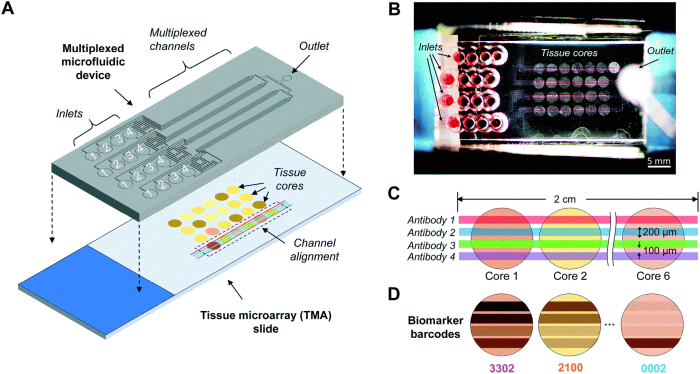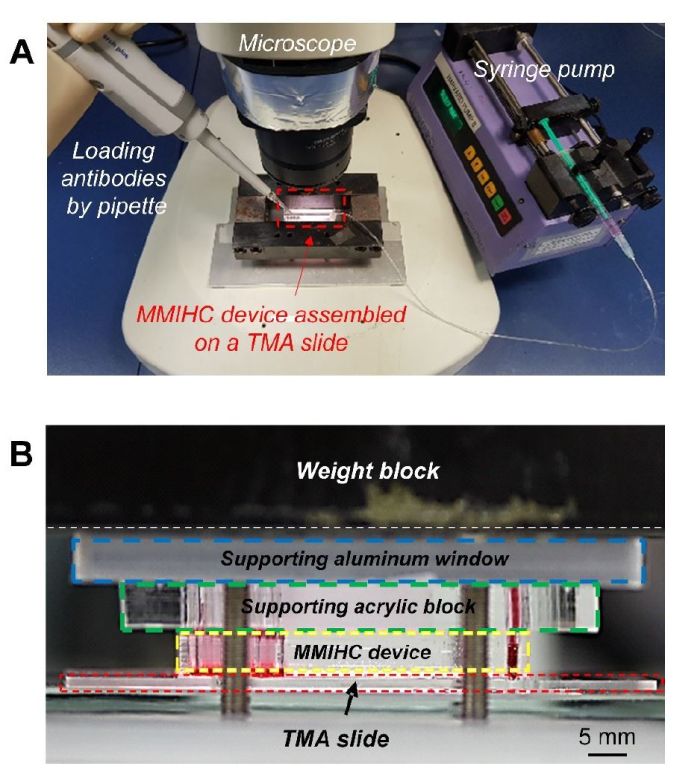
16 Jul Microfluidic biomarker barcodes enable high-throughput analysis of microarrays
In a recently published paper in the Lab on a chip journal, a research team from Korea Advanced Institute of Science and Technology (KAIST) reported a microfluidic biomarker barcoding device for multiplexed immunohistochemistry for high-throughput analysis of a tissue microarray.
“We present a multiplexed microfluidic immunohistochemistry (IHC) technology that enables high throughput analysis of tissue microarrays (TMAs) using the patterns of biomarker barcodes, which consist of a series of expressed linear patterns of specific biomarkers.”, the authors explained.

Reproduced from C. H. Cho, M. Cho and J. Park, Lab Chip, 2021, Advance Article, DOI: 10.1039/D1LC00375E with permission from the Royal Society of Chemistry.
The microfluidic chip was microfabricated using PDMS and standard soft lithography. The dimension of the device was 4.5 cm by 2.3 cm which could fit easily on a glass slide. The microfluidic chip was aligned and reversibly bonded with a weight block on the glass slide on which tissue cores were already placed in an array of 4 rows and 6 columns. Four separate microfluidic channels (200 µm by 50 µm by 2 cm) with four different inlets but a common outlet pass over each row. Each microchannel was connected to four reservoirs in which four different biomarkers namely, estrogen receptor (ER), progesterone receptor (PR), human epidermal growth factor receptor 2 (HER2), and Ki67, are pipetted. The common outlet is connected to a syringe pump that withdraws the reagent through the microchannels at a flow rate of 21.6 μL/h for 20 minutes.

Reproduced from C. H. Cho, M. Cho and J. Park, Lab Chip, 2021, Advance Article, DOI: 10.1039/D1LC00375E with permission from the Royal Society of Chemistry.
After the experiments, the microfluidic device was disassembled, and the glass slide was rapidly analyzed with a slide scanner. Each tissue core was exposed to four different antibodies and therefore depending on the presence or absence of the target antigen, four separate lines could appear over each core (See figure 1). Since each microchannel covers 6 different tissue cores, first the microfluidic device was examined to ensure that the immunostaining intensity was maintained even after passing through several cores. It was shown that regardless of the multiple cores, the intensity could be maintained by adjusting the antibody concentration. The microfluidic chip was then employed for multiplex analysis of 24 different breast tissue cancers on four tissue microarray slides and showed results comparable to conventional methods.
A unique barcoding system was used to analyze the results and determine the heterogeneity of the tissue. Depending on the expression level of the biomarker, a number from 0 to 3 was assigned. Therefore, each core could be identified with a four-digit number indicating the expression level of each of the four biomarkers which could also be presented with a color code. The barcode immunohistochemistry method was shown to be able to represent the unique pattern of tissue cores on the microarray and could be further developed for high-throughput screening.
“This “barcode-IHC” concept, which has been verified by performing multiplexed microfluidic IHC on CMA and TMA samples, provides high reproducibility and the potential of high-throughput screening with molecular diagnostic capability.”
Read the original article: Biomarker barcodes: multiplexed microfluidic immunohistochemistry enables high-throughput analysis of tissue microarray

Pouriya Bayat
Pouriya is a microfluidic production engineer at uFluidix. He received his B.Sc. and M.A.Sc. both in Mechanical Engineering from Isfahan University of Technology and York University, respectively. During his master's studies, he had the chance to learn the foundations of microfluidic technology at ACUTE Lab where he focused on designing microfluidic platforms for cell washing and isolation. Upon graduation, he joined uFluidix to even further enjoy designing, manufacturing, and experimenting with microfluidic chips. In his free time, you might find him reading a psychology/philosophy/fantasy book while refilling his coffee every half an hour. Is there a must-read book in your mind, do not hesitate to hit him up with your to-read list.


